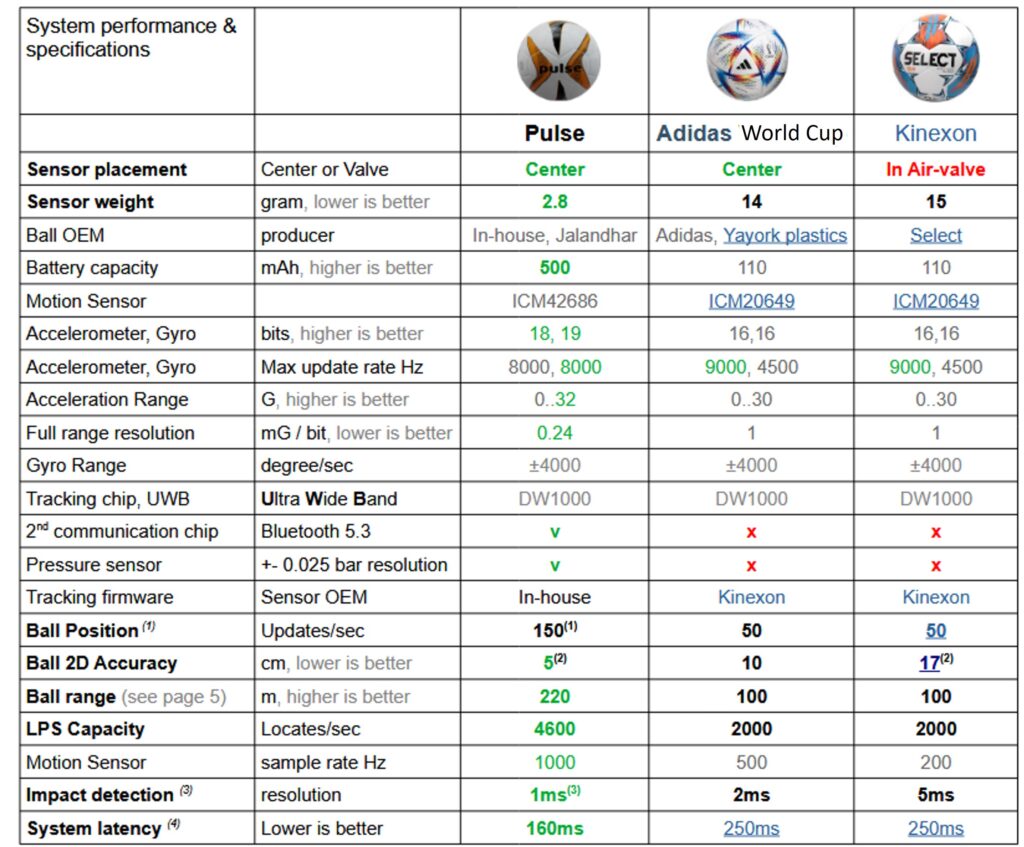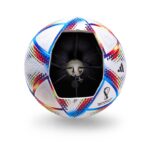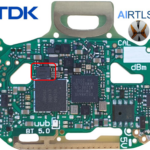Sensing in the 2022 FIFA World Cup soccer ball consists of a 6-axis motion sensor, a 3-axis magnetometer, a pressure sensor (in one version), and ultra-wideband (UWB) technology. The 0 to 2 bar (0 to 29 pounds per square inch (psi)) pressure sensor with 0.025 (0.36 psi) resolution can confirm that the ball is within FIFA guidelines and provide other information. According to FIFA rules, a regulation (one granted certification by FIFA for use in official matches) size 5 ball must have an air pressure between 8.5 and 15.6 psi. The UWB transceiver provides a real-time location system (RTLS) using two-way ranging or time difference of arrival (TDOA) measurements for the main position tracking.
For a 9-axis inertial measurement unit (IMU), a magnetometer with 3-degree accuracy helps to obtain the absolute orientation of the ball, otherwise the 6-axis accelerometer/gyroscope motion sensing only provides relative readings. With these additional readings, the system designer can develop the software, including the sensor fusion aspects, required for the end application.
Motion sensing technology
With FIFA’s Semi-Automated Offside Technology (SAOT), the IMU+UWB helps to improve the accuracy of the measurements for improved analysis. When the camera angle prevents certainty in the analysis, the IMU+UWB can provide additional, highly desirable supplemental information. If the only desired information is tracking the ball’s location or location tracking, then UWB+IMU can replace the video camera set-ups that use several cameras and do this with higher accuracy.
In AIRTLS PULSE design, the ball connects with UWB and Bluetooth technology to an anchor. Depending on the size of the field, an anchor would be required every 20 meters. Smaller, mobile anchors are used for tracking with the players having tracking units in their shin guards. The anchor connects to computers, servers, and the internet for data analysis. While all three versions of instrumented FIFA soccer balls use TDK InvenSense six-axis MEMS motion tracking sensors, the AIRTLS Pulse ball uses a newer generation motion sensor, as shown in Table 1.
Table 1. AIRTLS Pulse ball system exceeds the World Cup 2022 ball specifications.
The ICM42686 has a 20-bit analog-to-digital converter (ADC) that provides a 19-bit resolution for the gyro and an 18-bit resolution for the accelerometer. It turns out that 16-bit resolution was acceptable for the World Cup ball. However, with the newer generation sensor, the ball position can have 4,600 updates/sec, 5 cm 2D accuracy, 1000 Hz sample rate, impact detection of 1 ms resolution, and only 160 ms system latency. The motion sensing technology includes five distinct elements:
- A patented process,
- Advanced MEMS motion sensor design,
- Mixed-signal circuitry for sensor signal processing,
- MotionFusion and calibration firmware, and
- MotionApps software that consists of drivers and application programming interfaces (APIs) for application development on all major consumer electronics operating systems.
Figure 1 shows the MEMS sensor’s structure, including its packaging. In traditional MEMS fabrication, the complementary metal oxide semiconductor (CMOS) circuitry is attached to the top of the MEMS structure. In contrast, the patented InvenSense fabrication process enables direct integration of MEMS mechanical structures with standard CMOS at the wafer level.

It’s a whole new ballgame
Since basketball, rugby, and American football have a similar, air-filled design, they use similar technology for performance training. Smaller balls like tennis and hard balls such as golf balls or baseballs have the technology located in the racket, club, or bat. In golf, with the sensing in the club, the golfer’s swing can be analyzed. Since this impact is much greater in the golf ball-club interaction, a more robust sensor is required, as well as one with a wider measurement range. The short-time impact for the golf ball club could be a couple thousand G’s — and it is high speed. In the golf club, 32 G and ±4000 dps is sufficient for training. The packaging is the same as the currently used 2.5 x 3.0 x 0.91 mm LGA-14 package. While this is sufficient at this point, the trend is for even lower power consumption, smaller packaging, and lower noise.
With the visibility that the 2022 World Cup provided to UWB-IMU technology, can we expect to see more sports extending their analysis in training to competition? Li says that it is already occurring in rugby and American football and expects it to extend to other sports in the future. Based on the money that is at stake, that should not surprise anyone.
References
How Much Air Should a Soccer Ball Have? (soccermodo.com)



